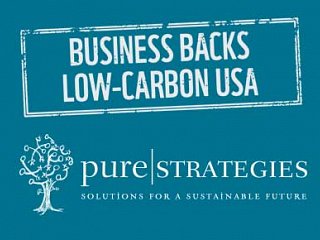Carbon farming offers a cost-effective way to draw down carbon from the atmosphere. No new technology is needed, no moon-shot innovation, just regenerative agricultural practices. Carbon farming is also key to reducing soil loss.
Read on…There is a lot going on in agriculture today. We see producers focusing on increasing yields, improving animal care, and reducing the toxicity of pesticides. The pollinator protection movement is fascinating; I am also seeing an explosion of interest in healthy soils.
Read on…National leaders in sustainable chemistry gathered at the Green Chemistry in Commerce Council (GC3) annual meeting hosted by Steelcase in Grand Rapids, MI this week to share inspiration, insights and explore the future of the field. Sally Edwards of UMass Lowell and I facilitated a workshop on the business case for The Chemical Footprint Project (CFP).
Read on…Climate change presents the critical challenge for our time. The measure of our response will determine the quality of life for generations to come. All of us — individuals, business and government leaders, scientists and educators — must make addressing climate change a priority.
Read on…Does your business embrace the disruptive forces of a low-carbon world as Ford and Ben & Jerry’s are? Over the next 10 years, climate change will drive industrial disruption at rates that previously seemed unimaginable. In response, policy makers must come to terms with the need to keep the mean global temperature rise to 1.5°C.
Read on…Sustainability is being driven by large forces at play. Consider that we have a global population of more than 7 billion people who all want to live like we do here in the U.S. That puts incredible strain on our natural resources. Add to that the fact that the climate is warming at an unprecedented rate.
Read on…The inaugural Chemical Footprint Project report released this week highlights the financial risks that companies face due to chemicals of high concern (CoHCs) to human health and the environment in their products and supply chains.
Read on…At the corporate level, pricing carbon allows companies to redirect funds toward sustainability investments, such as renewables, energy efficiency and energy storage, which can drive further cost savings in the long run.To get a better understanding of pricing carbon in the corporate world, we spoke with Tim Greiner, co-founder and managing director at sustainability consulting firm Pure Strategies.
Read on…My recent meeting with the Boy Scouts of America and their suppliers radically shifted my view of what the Scouts are about. My impression of the Boy Scouts was stuck in my experience as a Scout back in the ‘70s. As a middle schooler, I joined the Scouts to hang out with my friends. I loved the outdoor activities and the pursuit of merit badges.
Read on…I highly recommend this insightful article by Jeffrey Hollender, Former CEO and Co-Founder of Seventh Generation and Founder and CEO of Sustain. He challenges businesses to chart a path that is net positive, restorative and regenerative. Sharing his experiences as CEO of a sustainable condom company, he highlights the work he and I did together to develop a "roadmap to becoming net positive" by developing a framework for tracking both positive and negative impacts in four areas important to Sustain's mission.
Read on…A company may not know how it will achieve the more ambitious future goal but it knows it needs to be investing in innovation and motivating its employees to develop game-changing solutions. The longer-term targets also help ensure that the company’s short-term investments support lasting solutions, such as renewable energy or product innovations.
Read on…Just as companies evaluate their carbon, water and waste footprints, the CFP finally provides a tool that enables purchasers and brands to: benchmark and measure progress towards safer chemicals; recognize and reward suppliers for doing what matters most to retailers and customers; create greater accountability across value chains; encourage chemical information sharing; and provide a metric to compare and measure continuous improvement of suppliers.
Read on…Engaging a group of suppliers through a specific product category survey is one of the most effective ways to tackle key product impacts, especially for retailers seeking to elevate the performance of an entire category of products, as opposed to select companies.
Read on…To help guide companies managing this added pressure, Pure Strategies, evaluated how leaders in the formulated products marketplace have constructed their goals, strategies, tools and partnerships. What is at the core of these programs — and what makes them successful?
Read on…Chemicals and materials in products, processes, and packaging are facing greater scrutiny and growing demands from retailers, regulators, competitors, and consumers - new rules of the game are rapidly emerging.
Read on…Seventh Generation, the Vermont-based household goods company known for its pioneering work on ingredient disclosure, has found success linking bonuses to sustainability goals. The bonus tie-in increased employee awareness of the company’s priorities and ownership of the four sustainability goals selected — helping the company meet all of these goals in 2012, as detailed in the company’s 2012 Corporate Consciousness Report.
Read on…Why do sustainability achievements come naturally for some companies, while others struggle to achieve even modest targets for impact reduction? I wish I could say the difference is some companies hire our sustainability consulting services and others don’t. But the truth is, despite abundant guidance and support, I’ve seen some clients take only faltering steps, while others take the ball and run. So when a company clearly has winning ways, it makes sense to take a closer look.
Read on…Two very different news stories caught my eye at the end of May. The initial article in Triple Pundit, praised ten companies for the excellence of their sustainability reporting. The other, in the Guardian, reported on a Union of Concerned Scientists (UCS) study of 28 publicly traded companies in the S&P 500 that work both sides of the room to influence the debate on climate change. The study found that some businesses claim to care about climate action while quietly supporting groups working to discredit climate science.
Read on…


















